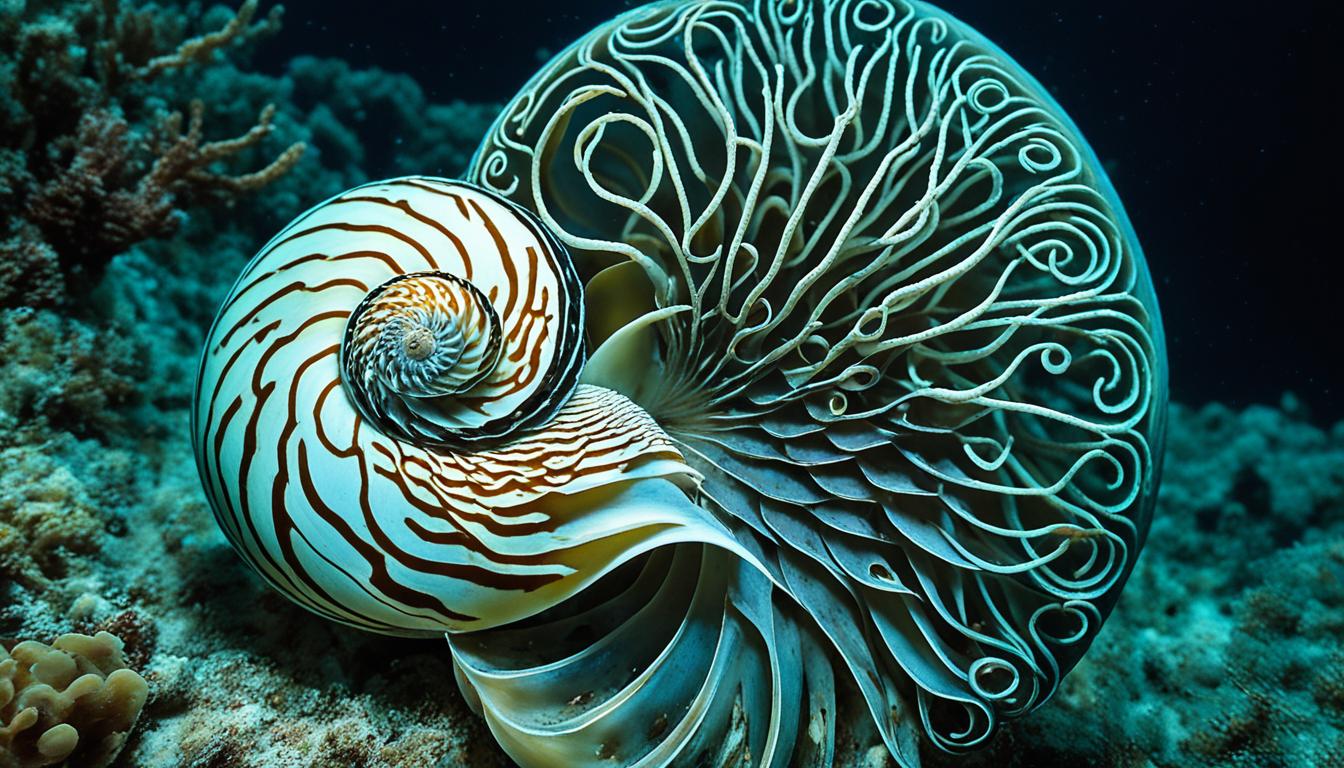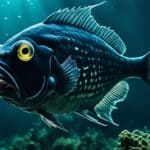The nautilus is a unique creature of the deep sea. It has many fascinating adaptations that help it survive in a tough ocean environment. Its coiled shell is just one of the many ways it has adapted over millions of years.
These adaptations are key to understanding how the nautilus can live in the deep sea. Its shell helps it stay buoyant, and its unique behavior lets it move through the dark depths. This helps it use energy wisely and increases its chances of surviving in such a harsh place.
Learning about deep-sea nautiluses shows us how important they are to the ocean’s health. Their biology is a key sign of how well the marine ecosystem is doing.
Understanding Nautiluses: Ancient Deep-Sea Dwellers
Nautiluses are amazing creatures that have lived for over 500 million years. They are true ancient deep-sea dwellers. Their ability to survive shows how well they have adapted to life under the sea.
The History of Nautilus Evolution
Nautiluses have been around since the Cambrian era, a key time for marine life. Over millions of years, they have changed very little. This shows how well they have adapted to life in the deep sea.
Nautiluses live in the Mesophotic Zone, a place with little light and many different kinds of life. This zone is tough, with little light and limited resources. Nautiluses have developed special ways to survive, like their strong shells for staying buoyant and safe.
Their shells are not just for protection. They also help nautiluses move through the water easily. This lets them travel through the deep sea with no problem.
Learning about nautiluses and their evolution helps us understand how they’ve stayed important in a changing world. They are key to marine ecosystems, showing how some creatures can last for millions of years.
How do nautiluses adapt to deep-sea environments?
Deep-sea nautiluses have evolved special traits to survive in tough marine habitats. They moved from shallow to deep waters about 60 million years ago. Since then, they’ve developed unique behaviors and body features. These help them live in places with little light and few nutrients.
Evolutionary Background of Nautiluses
Nautiluses have shown great adaptability over millions of years. They’ve changed their biology to better survive in deep sea conditions. They’ve grown strong shells for protection and use energy wisely to last long without food.
Their ancestors lived in shallow waters and slowly moved to deeper areas. This shows how survival and adaptation are linked in the ocean.
The Role of Nautiluses in Marine Ecosystems
Nautiluses are key to keeping the ocean balanced. They eat dead animals and put nutrients back into the ecosystem. This is vital for the nutrient cycle in their homes.
By eating decaying matter, they help the marine environment stay healthy. They make sure energy moves between different species. Their slow metabolism helps them survive in deep sea, where food is scarce.
Physical Characteristics that Aid Adaptation
The nautilus has special traits that help it live in deep-sea environments. These features are key for survival and play a big role in its deep-sea life. They show how nautiluses move through the water with great skill.
The Unique Shell Structure of Nautiluses
The nautilus has a spiral shell with many chambers. This design protects it and helps with buoyancy. It can change its buoyancy by adjusting gas and liquid in the chambers.
This lets nautiluses move up or down in the water easily. It’s vital for finding food and avoiding predators in deep-sea habitats.
Buoyancy Control Mechanisms
Nautiluses control their buoyancy well, which helps them move in the water. To go up, they change the gas in their shell. This is like how submarines change depth.
This keeps them at the right buoyancy level. It saves energy, making hunting and avoiding predators easier in the deep ocean.
Size and Weight Considerations
Size and weight are important for nautiluses in the deep sea. They usually have a shell about 20 to 25 cm long. This size affects how they move through the water.
Being light and having a streamlined shell helps them hunt better and avoid predators. These size factors show how nautiluses survive in deep-sea challenges.

Nautilus Behavior in the Deep Sea
Understanding how nautiluses behave is key to seeing how they survive in deep-sea life. They have a unique way of moving up and down in the water. At night, they go to shallower waters to hunt for food like shrimp and small fish. This helps them use the twilight zone to feed safely.
Vertical Migration Patterns
Nautiluses move up and down to get food and avoid predators. They go deeper during the day to stay safe from predators that hunt by sight. This shows how they balance finding food with staying safe in the deep sea.
Predator Avoidance Strategies
Nautiluses also have ways to avoid predators. They control their buoyancy to stay hidden from predators. This lets them get food without becoming prey. Their behavior shows how they’ve evolved to live in the deep sea by finding food and staying safe at the same time.
FAQ
How do nautiluses adapt to their deep-sea environments?
Nautiluses have special shells that help them stay buoyant. They also move efficiently and use less energy. Their shells have chambers that let them control their buoyancy. This helps them move through the deep sea with ease.
What evolutionary traits have nautiluses developed for survival in the deep sea?
Nautiluses have evolved over millions of years. They have a spiral shell for protection and to stay buoyant. They also move vertically to find food and avoid predators.
What role do nautiluses play in marine ecosystems?
Nautiluses help marine ecosystems by cleaning up dead organisms. They act as scavengers. Their presence shows how healthy the ocean is. They help keep the ocean in balance.
How does the nautilus’s buoyancy control work?
Nautiluses control their buoyancy with their special shells. The shells have chambers filled with gas or liquid. This lets them move up and down easily, like a submarine.
What are the predator avoidance strategies of nautiluses?
Nautiluses avoid predators by moving deeper during the day. At night, they forage in shallower waters. They use their buoyancy to stay hidden from predators.







